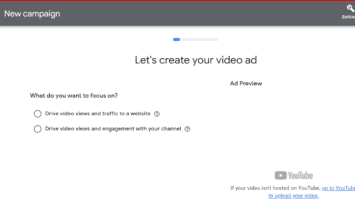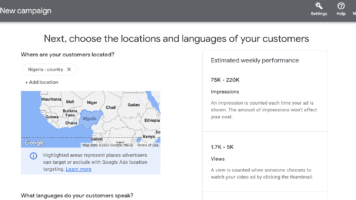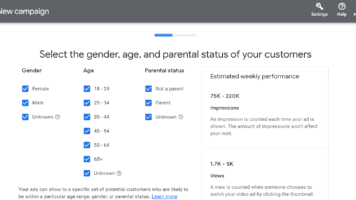Youtube is the second most popular website with about 2 billion monthly visitors. It is one of the most effective advertising platforms today, as it allows businesses to reach their target audiences. Being the world’s largest video-sharing platform, businesses can now drive awareness, engagement and conversions. Campaign advertisements can now reach their full potential with youtube ads.
With the perfect script, story, shoot and video, you would want to reach a wider range of audiences. You would not just want this video to sit on your website or homepage, but to reach more people for more views.
If you are allocating a video ad budget, youtube is a great way to start, as it has a powerful targeting capability with a high ROI later. Well, let us dive into the different types of youtube ads and a comprehensive guide to how to set up youtube ads for beginners.
Table of Contents
ToggleTypes of youtube ads
#1. In-feed video ads
In-feed video ads appear on the homepage, search results page and as related videos on video watch pages. It shows to users who are highly engaged and searching for videos related to the ad. This ad consists of a thumbnail image from your video and some text.
They are similar to Google search ads, as it appears on the search results page of youtube. This way users can also view youtube as a search engine. It has no max length and could be as long or as short as you like.
You will be charged only when viewers watch the ad by selecting the thumbnail. You should use this ad format if your campaign goal is for brand consideration.
An example of an in-feed ad that shows up on the search results page after making a search query:

#2. Skippable in-stream ads
Skippable in-stream ads are the standard youtube ads and it is also the most common type on youtube. These youtube ads are paid for only when a user
- Watches the ad for up to 30 seconds
- Watches the ad completely
- Clicks on the call to action that redirects them to a brand’s page
Skippable in-stream ads have no maximum length but are recommended to be less than 3 minutes long. These ads play for a minimum of 5 seconds before the user now has a choice to skip the ad. They appear on youtube watch pages and across websites and apps running on Google video partners.
Advertisers often customize video ads with call to action and overlay text. This is an example of skippable in-stream ads:

#3. Non-skippable in-stream ads
Non-skippable in-stream ads can be played anywhere when watching a video. It can pop up before, mid-play or after the main video. It has a duration of 15-20 seconds and it can not be skipped by the viewers.
These ads only show up mid-way in videos that are at least 10 minutes long. On a desktop version, a countdown of 5 seconds is displayed before the ad plays. Viewers can not skip this ad so they view the whole message.
Non-skippable ads use target cost per impression and you are charged based on impression. You can use this when your goal is to create brand awareness and reach.
#4. Bumper ads
Bumper ads are 6 seconds, non-skippable and play before a video. They are the shortest youtube ads and as the name implies, it just bumps into the video. They are perfect for advertisers that want to display a quick message to raise awareness.
These ads may seem like they need to be longer to raise awareness, but when used in combination with other video campaigns they make a lasting impact. So make sure to use your 6 seconds wisely and include the essential features you want viewers to take note of.
You are charged based on impressions and you can use this youtube ad when your campaign goal is brand awareness and reach.
#5. Masthead ads
Masthead ads are used to drive awareness and reach a larger audience in a short period of time. Although this ad is only available on a reservation basis through a Google sales representative.
The way the ad is displayed depends on if the device used is the desktop, mobile or tv screen version. You will be charged based on the cost per thousand impressions and you can get a rate estimate through a Google advertising team.
How to set up a youtube ads campaign
#1. Upload youtube video
First, upload the video you want to use for ads on your youtube channel.
#2. Go to your google ads account and set it up
Set up your Google ads account and link it to your youtube channel. Here is the Google ads page to set it up.
#3. Create a new ad campaign
When you get to the new campaign page, you will be required to choose from these two campaign goals; “Drive video views and traffic to a website” or “Drive video views and engagement with your channel”

Selecting the first option allows you to create an in-stream ad and the second option allows you to create an in-feed ad. Search for your video or paste its URL in the select video bar.
After selecting the first option, this shows up.

Enter the link of your landing page, your call to action button and a headline.
After selecting the second option, you are prompted to enter a headline and descriptions for two lines.

You can also see a desktop or mobile version ad preview on the right. For advertisers who are familiar with youtube ads, they can switch to expert mode for more advanced features such as keyword or placement targeting.
#4. Choose audience location and language
What languages does your audience speak and where are they located? Add your customers’ locations and the languages your customers speak. Add as much as you require for your youtube ads.

Your estimated weekly performance is displayed on the right side. You can see the estimated weekly impression, views, and average cost per view as you add more locations or languages.
#5. Select the gender, age and parental status of your customers
Now you need to select your audience demographics. There are three options for the gender category; female, male and unknown. The age category is grouped into 6 age groups and an unknown option is available.

Select your status in the parental category. Are you a parent, non-parent or unknown? Choose the demographics according to your target audience for your youtube ads.
#6. Select people with the specific interests you want to target
What do you think your target audience will be interested in? Search for interests and pick the ones that match the interest of your audience.

Do not forget to monitor your estimated weekly performance to know your estimated impressions, views and CPV.
#7. Set a budget
Having a budget set aside for every campaign is a necessity. How much do you plan to spend per day and how much do you plan to pay for the successful execution of an ad campaign?
Now you need to input your planned daily budget/spending in whatever currency you selected when setting up your Google ads account. Select how long you want to run your youtube ads. Do you want it to run continuously or do you want it to have an end date? You can determine the end date if you select “select an end date”

Keep in mind that on some days you might spend less than your daily budget and on others, you might spend more. Here is a way to run ads on any budget.
#8. Review and Launch the campaign
After accurately putting in the necessary details for your youtube ads campaign, make sure to review your campaign and be sure that is how you want it to be. You can edit any category that you want to change.
Input your credit/debit card info and submit it, and then you are good to go!
Tips for running a successful youtube ads campaign
#1. Set goals for your video ads
Every campaign needs goals set as the first step in creating a successful campaign. With your goals determined, you are able to know what type of youtube ads you want.
#2. Determine your target audiences
Determine the type of viewers you want to see your ad. You should know your target audiences so you can be able to create the right ad for them.
#3. Get creative with your youtube ads
Your video ad should be highly creative and visually engaging for your audience. You are more likely to achieve your campaign goal with a creative ad.
#5. Test and optimize ads
Testing and optimizing ads can help you determine what is working and what is not working. Experiment with different targeting options, and ad creative, to find the most effective approach.
#6. Analyze data results
Regularly analyzing data from your youtube ads campaign can help you to make data-driven decisions and adjust your campaign accordingly.
Conclusion
Youtube is one of the largest search engines and is great for video ad campaigns. Creating Youtube ads is a great way to reach your target audiences in a visually appealing way.
It is important to know the types of youtube ads, and your campaign goals before setting up a youtube ads campaign.


![60+ Best Free WordPress Themes [Best pick for 2022] Best Free WordPress Themes](https://adstargets.com/blog/wp-content/uploads/2022/09/Best-Free-WordPress-Themes-150x150.png)






